12. Case Study: Higher Ed
Twitter: A Community Education
The thing that Twitter has is a sense of community, which is very similar to that of higher education—there’s also the opportunity to engage with so many different people instantly.[i]—Sarah Cunnane, Editorial Assistant of features and books for Times Higher Education. Cunnane summarizes why many early adopters in higher education are using social media; specifically Twitter. Through this 140-character microblogging service, learning and level of engagement is heightened and arguably intensified in small communities on Twitter as conversations form and new voices opt in to the conversation.
Having been affiliated with the secondary and higher education communities for over 10 years—first as a student, then as a high school teacher, and most recently an employee of both a community college and large university, I continue to witness opportunities for social media to transform the level of engagement and crowd sourcing that occurs. Information consumers are now producers, and knowledge sharing isn’t limited to those with a teaching certificate. Didier Oillo, Creator and Director of the Virtual University of the French-speaking world is a specialist providing ICTs for underprivileged and marginalized population. Oillo elucidates a point that challenges new Web 2.0 users: Young people are mastering this media faster than the teachers[ii]. Additionally, the traditional roles of teachers and students are changing as teachers serve as conversation mediators and facilitators, and students become creators of knowledge and not merely consumers.
Why Higher Education?
According to Fast Facts from the National Center for Education Statistics, 18.4 million students are expected to attend 2-year and 4-year colleges and universities in the United States; an increase of about 3.1 million since fall 2000[iii]. These students will add to the current body already versed in social media. Though Facebook is currently the social media site that people in the 18-25 year old bracket prefer[iv], Twitter is gaining popularity among faculty and administrators as a communication tool that doesn’t involve poking friends or tagging photos[v]. A growing number of admissions offices, university foundations and alumni associations are leading the higher education community in using Twitter to engage their communities in multiple ways. Based on a survey[vi] of approximately 2,000 higher education professionals conducted by Faculty Focus, 71.8 percent of those who use Twitter expect their usage to increase this school year, with additional findings predicting relatively strong adoption rates among higher education professionals.
Of those institutions currently exploring social media’s place in their institutions, the growth trends observed in a 6-month period show adoption of social media. The data[vii] gathered by BlueFuego[viii] shows that approximately 17.8% of higher education institutions using the .edu domain, have a clearly visible social web callout, or SWC[ix] on their university website. Of these sites, Twitter showed a 39.9% increase in visibility on .edu homepage links from March to August 2009, with Facebook links increasing by 17.7% and YouTube by 5%. Schools are realizing the importance of social media visibility. These callouts serve as free advertising and put the power in the hands of the community as they are given license to connect with the organization on a personal level.
But presence on a social media network, or SMN, doesn’t equate engagement. Twitter, as with any communication tool, is only as effective as those who use it. Some still question the reach or relevance of Twitter in a setting such as higher education. Just how many in higher ed are using Twitter? Based on wefollow’s list of #education Twitter users, there are approximately 4,444,416 followers in this tag at the time of publication. Of this number, 249,552 are #highered users, and this number is growing. These trends are predicted to continue to grow exponentially as more institutions are finding ways to incorporate Twitter in campus-wide communication and marketing portfolios. Nielsen Wire reported in July 2009, that: among the top 10 social media sites, Twitter was again the fastest growing, increasing 1,928 percent year-over-year, from 1 million unique visitors in June 2008 to 21 million unique visitors in June 2009–making Twitter the fourth most visited member communities site in June.[x]
Currently, Twitter is serving a range of needs for the higher education community. CampusTechnology.com, for example, reports[xi] that Oregon’s Pacific University is one of many institutions integrating their emergency notification systems with Facebook and Twitter, giving members of campus the option to receive alerts through these social media sites. In addition to this service as an emergency broadcast system, schools are exploring its use as an initial point of contact between prospective students and admissions personnel, to create and maintain relationships with alumni, to build professional networks with colleagues in higher education, and as a classroom tool to foster community. Consulting companies like Inigral and BlueFuego see this growing development in higher ed marcom[xii], and are ready and willing to assist interested parties in transforming traditional forms of communication and marketing to building a robust social media presence.
As institutions re-image themselves as approachable entities that strive to be where their communities are, higher education is poised to lead conversations, research and models for student/staff/faculty/alumni engagement via microblogging. For those institutions new to Twitter, this chapter is intended to serve as a resource that highlights best practices and models for consideration, specifically in the way that colleges and universities:
- Understand Twitter and its capacity as a communication tool;
- Incorporate Twitter in marketing and communication plans;
- Build brand and voice recognition;
- Engage their constituents;
- Gauge Return on Investment (ROI)
Methodology
For anyone interested in following tweets related to #highered, you have your work cut out. Do you want to follow institutions? If you want to follow institutions, do you want to follow the Alumni association? Student groups? News? Athletics? Departments? Marketing companies who work with higher education? Higher ed personalities (deans, presidents, VPs, social media managers, professors)? Who or whatever you choose to follow could lead you to very different twitter accounts with different purposes. In my own quest to narrow down a focus for this chapter, I followed the following process:
1. I first got a sense of the landscape by browsing through .eduGuru. Though their website says that they blog about internet marketing and web development in higher education, I didn’t just find marketing and web development info—I found info related to 2.0, social media, analytics, best practices and information about others in higher ed who follow their blog. Additionally, they compiled a list of individuals in higher education who tweet. And this list is growing.
2. Next, I looked at themed lists. These are one-stop-shops to find universities, colleges, higher ed marketing strategists, web designers and personalities who have a twitter and social media presence. Here are a few that I used:
- PBworks has a University fan wiki that you can edit and add your institution.
- Higheredtweeters.com is a compilation of higher ed tweeters started by Marie Howell. The irony? The Twitter handle she lists for herself isn’t valid.
- The Chronicle of Higher Education put out a list of 10 to follow on twitter. The list represents different facets of higher education: professor, student, public relations, president, researcher, and lecturer.
- Social Media Club started an education group. Look at their list to see who is teaching social media across the country and world.
Additionally, I looked at the following sites and tools:
- Twellow, where you can search for a broader term like education or research, or college & university students. There are 12 more categories in education if you need a more granular level within higher education.
- Wefollow’s generic “education” list;
- blogs like that of higher education marketing consultant, Karlyn Morrissette, who created a Master Higher Ed Twitter List where she has added twitter handles of higher education personnel she’s come in contact with. People have continued to add their info in the comments section. It’s a loooong list.
- Distance-Education.org: list of 75 most useful college education resources on twitter for both online and traditional students. This list highlights those resources providing daily updates and links to articles, tips and advice. Something akin to student support via twitter.
- Twubble: Searches your friend graph and picks out people who you may like to follow.
- Just Tweet it: User directory for Twitter organized by ‘genre’ to allow for users to easily find other Twitter users with whom to connect.
- TweetFind: Live Twitter directory to Find Twitter Users and Twitter Businesses.
- TwitDir: Another Twitter directory that allows you to search within names/usernames, location and description. It also lists: Top 100 followed, Top 100 updaters, Top 100 favorite-rs, Top 100 followers and the formula used to calculate the TOP lists.
3. Hashtags: An additional approach I used is a hashtag (#) search. This is a little trickier than using lists such as the ones mentioned above. For some searches, hashtags are very much like keywords and I was able to search by common words associated with higher education, and come up with a good list. But, there are times when hashtags aren’t as obvious, or hashtags are created around particular events, making it a little more of a guessing game when searching for relevant hashtags. One place I began was a hashtag directory: http://hashtags.org
4. Follow the leader(s): This may seem obvious, but why not follow the leaders? Higher education is such a broad field that it was a manageable task to identify thought leaders who follow other leaders or interesting people/brands. I scrolled through these leaders followed and who followed them. You may even find that you’re separated by six degrees or less.
The following profiles will be used to illustrate best practice models, based on a combination of how often they appeared using the search tools above, word of mouth, references on high profile sites such as Mashable and mStonerblog, and how they used Twitter to engage (conversations, hashtags, voice, @s, RTs)

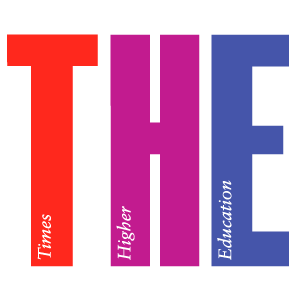


Why Twitter?
For those colleges and universities who maintain Twitter accounts, what brought them to this decision? For Erika Younkin, Assistant Director of Communications for the University of Colorado at Boulder (CUB) Office of Admissions, it was about diversifying their communications tools to reach more people, and being present on sites that their audience frequent. We knew we weren’t going to reach everyone. People have preferred ways of receiving news and information, so if Twitter is a main source of news for a smaller population of students and parents, it’s still important for us to be there…We try to listen and react to our users as much as possible. Younkin, like a growing number of higher ed tweeters understands that adding Twitter to their communication portfolio expands their reach as an office and enhances service to the public. When asked why people should follow @MyCUBoulder, Younkin remarks that her office provides updated information about the CU-Boulder Community. Furthermore, she speaks to her knowledge of the prospective student community: many of our prospective students know early on that they want to come to school here. Twitter can help them stay connected to us easily.
For others, Twitter is a place where they can be present, listen, and respond or share unlike any other site. Sarah Cunnane cites the UK’s Minister of Science in Business, Innovation and Skills, Lord Paul Drayson as an example of how Twitter is opening lines of communication among higher officials in education and government and ordinary people like you and me. I cannot think of any other social media where that would be possible, she remarks. In bypassing the ‘official’ channels to ask questions and seek information, learners are empowered to seek new information sources and serve as peer resources.
Was it easy to begin a university Twitter account? Did early adopters meet resistance in creating an official presence on this microblogging site? For the most part, it was an easy sell, once Twitter was demystified. A member of the Web Development Team at Arizona State University recalls the beginnings of the @ASU and @ArizonaState accounts: I opened @ASU and @ArizonaState in January 2009. At the time, I worked for University Student Initiatives. My supervisor had asked me several times about Twitter, but was reluctant to open an official account until she had spent some time getting to understand its usage. She finally gave permission to register the username, and within the first couple of weeks other departments were contacting us figuring out how to tweet from the official @ASU account. David Baker, Director, Web Communications at Oregon State University adds to this conversation by sharing that leadership in his office embraced a launch and learn culture, making it a natural move to explore Twitter as a useful communication tool once it gained momentum, while still learning about the tool as it evolved.
Twitter is a 24/7 learning community
Twitter and higher education fit so well together because of the nature of higher education, remarks Kegan Sims of Oregon State University’s “Powered by Orange“ campaign. People are always looking for more information, Sims continues. Twitter is a great resource to act as an answer desk of sorts. On the same note, it gives personality and life to what is typically a very institutional and “boring” area. Sims recognizes what seems a natural venue for the higher education community to dialogue: the Twittersphere. With each 140-character tweet, Twitter is proving its ability to reach diverse audiences with varying needs, from crowdsourcing research, to reaching potential donors, to soothing frustrated students.
Twitter’s reach in higher education is an easy sell to individuals wondering how a Twitter presence could be useful. Baker reflects on Twitter’s ability to reach the masses: Higher ed is so broad, and has so many niche communities, Twitter is perfect for many of them. That’s the great thing about social media in higher ed in general…you can always find an audience within our constituencies, whether it’s technology businesses that work with our business and engineering programs, or arts communities, or scientists and researchers, students, parents, international students, etc. We’ve got them all. As the higher education community begins to move conversations to Twitter, we will find the teaching and learning community’s dialogues archived in a public space. Conversations around trending topics in higher education now have the ability to reach the Twitter streams of thousands, with the help of hashtags (#) and RTs. This is scary for some who are protective of their research and knowledge. But for others, Twitter is a welcome service. Geographic borders are no longer an issue in resource sharing. @s and RTs have enabled the higher education community to survey, critique and transform the teaching and learning community and propel education to positions of leadership and scholarship.
A member of the Arizona State University’s web team remarked that he appreciated that conversations that were previously private, were now opened to public dialog. From a customer service perspective, he says, you no longer have to wait for an Op-Ed to come out criticizing or praising a policy or situation. Now, if something happens (whether positive or negative), we can address it instantly[xiii]. These comments are generally shared across industries as Twitter and other social media networks flatten the hierarchy of institutions and organizations, making it easier for two-way communication.
The New Rs of Education + Social Media: Recognition, Response, Relevance
#1: R is for Recognition (of your brand)
In higher education, alumni and athletics programs perhaps understand the game of brand recognition the most. They rely on university logos and marks to communicate shared understandings and elicit emotional responses (hopefully cheerful ones) from members of the community. If Twitter is an extension of the marketing and communication portfolio of an organization, its branding should accompany it to Twitter.
@ASU is a great example of how their university branding extends to Twitter. The image on the left is @ASU’s Twitter page, and to the right is ASU’s website. It is apparent that the resemblance of the Twitter page to the website is intentional, right down to the grey background.
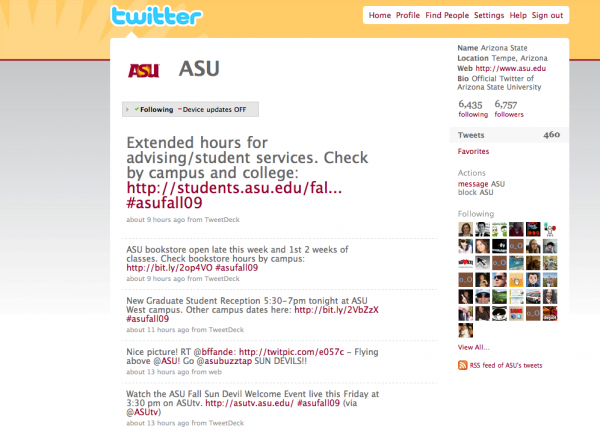
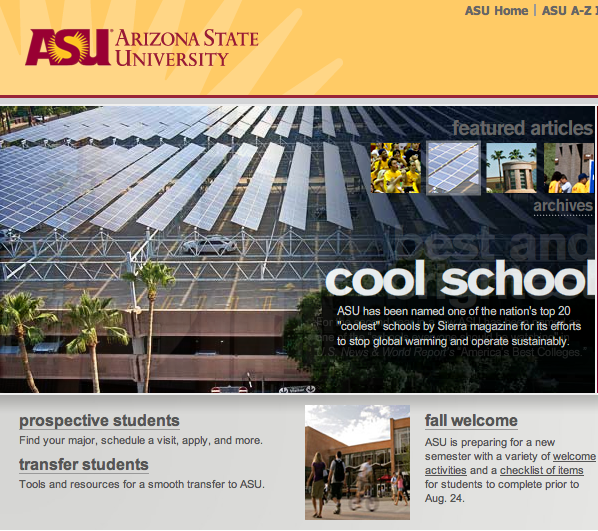
OSU’s Powered by Orange campaign also does an excellent job in branding. Though they are a marketing/alumni campaign of Oregon State University and their bio link points to the OSU website rather than poweredbyorange.com, it distances itself from the traditional brand of the university by establishing a new brand. The Twitter background is consistent with all of OSU’s PBO social media sites. The large orange circle is easily identifiable and is prominently displayed and the color scheme matches the website/blog. Depending on how you look at it, the background could seem incredibly boring and drab (the reaction I got when I asked a friend’s opinion), or visually satisfying in its simplicity. The dark background doesn’t necessarily elicit energy and excitement, but one could also say that this focuses the attention on the orange circle—a symbol of the campaign. In this case, I err on the side of simplicity. 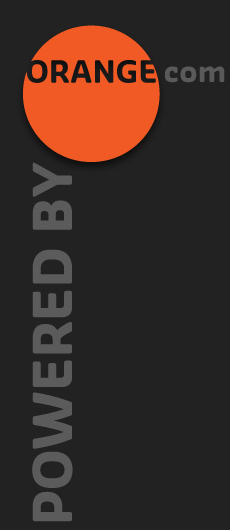
University of Colorado at Boulder has an added component to their Twitter profile making it evident that it represents the CUB community. A weekly tweet invites followers to submit photos of the campus and surrounding Boulder community. 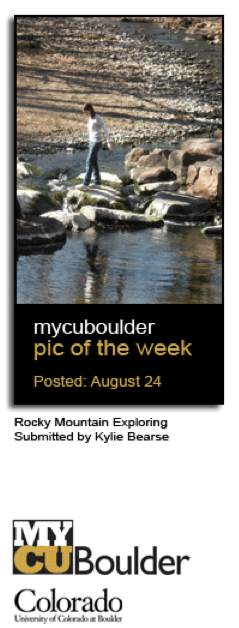 After a photo is chosen, the @MyCUBoulder Twitter page is updated to reflect the photo of the week. @MyCUBoulder gets that brand recognition isn’t only done with school colors and logos, but by representing the community’s physical and social environment, as evidenced in the photos posted. The invitation to submit photos also invites followers to continue to build their brand and presence on Twitter.
After a photo is chosen, the @MyCUBoulder Twitter page is updated to reflect the photo of the week. @MyCUBoulder gets that brand recognition isn’t only done with school colors and logos, but by representing the community’s physical and social environment, as evidenced in the photos posted. The invitation to submit photos also invites followers to continue to build their brand and presence on Twitter.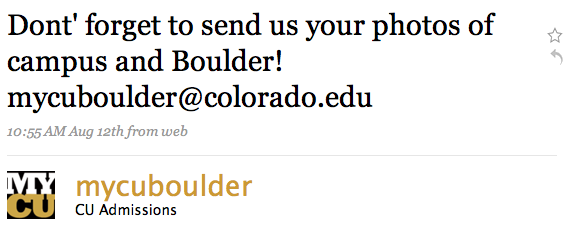
#2: R is for Respond & Reach Out
A January 2009 article[xiv] in University Week stated that Wayne State University in Michigan was taking an original stand on Twitter by using it as a customer service tool to listen, address and respond to problems voiced on Twitter. Higher education joins other industries in using Twitter to listen and respond. Whether it’s a prospective student asking for information about a major,
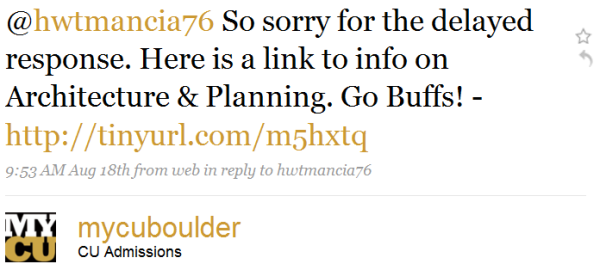
or recognizing your 300th follower on Twitter,
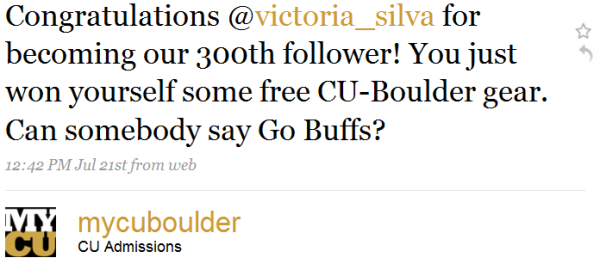
students and universities alike have a forum where their concerns, praises and questions may be voiced, and if both parties are listening, continue to dialogue. And sometimes, it’s just there so people know that someone is listening and noticing.
Higher ed has also seen success on Twitter as it creates opportunities for followers to interact. David Baker at Oregon State University says[xv] that in the daily tweets they send out, they will include occasional “pulse” tweets designed to gather responses, such as: “It’s a beautiful day, what do you like to do on the MU quad in great weather?” @MyCUBoulder believes in being a resource to their followers. When asked[xvi] if they target a particular demographic, Erica Younkin of University of Colorado-Boulder said they didn’t. Cognizant of the groups that follow them—prospective students, parents, CU organizations, and local businesses, they use style guides and school policy to build their social media campaign to keep them all engaged.
#3: R is for Return on Investment (ROI)
One issue that has kept people on the fence regarding adoption of social media in their communication plans, is the matter of time. It’s not just a question of staff time spent on Twitter, but what the institution is receiving in return. For something as amorphous as Twitter, and social media in general, how does one begin to measure success? Does it rest in the number of Retweets (RT), @s, DMs and followers? If so, are there tools available and affordable to gather these metrics? Twitter is no different than any other marketing tool in its ability to provide real time market research for organizations. Though higher education institutions vary in their interest or knowledge about Twitter metrics, it is important to know where and how to access these tools. But even before building a metrics toolkit, it’s crucial to know what it is you are measuring. For some, measuring engagement with followers is important. For others, the increase (or decrease) in the number of followers is significant. Be able to define what insights you seek.
The Takeaways
Higher education has great capacity for Twitter. With its varied uses ranging from news feeds, to event invites to online note taking, the academic community can only benefit from what Twitter has to offer. As organizations flatten hierarchy and control over who creates and consumes knowledge, Twitter finds relevance within the multiple areas of higher education that are willing to grow with this tool. As a more freeform application, its customizable features enable users and followers to set the level of engagement as they see fit, allowing tweeters to ease in to the technology and discover is usefulness within each one’s facility. As with other new technologies and opportunities, the only way to understand how it works in a particular context, is to do it.
So as higher education tweeters and spectators continue to observe and predict and attempt to analyze Twitter’s value within higher education, know that what we are able to surmise today may not be what it will be next month, largely because we are shaping this technology as it emerges. As much as we’d like a roadmap on this journey through social media, there isn’t one. What we can do, however, is be prepared for whatever opportunities present themselves and be ready to adapt.
The Thought Leaders
[i] Sarah Cunnane, interview by author, 14 August 2009, Seattle, WA, e-mail questionnaire.
[ii] http://www.unesco.org/en/wche2009/single-view/news/icts_changing_the_face_of_higher_education/back/9712/
[iii] http://nces.ed.gov/programs/projections/projections2017/tables/table_10.asp
[iv] http://www.insidefacebook.com/2009/07/06/college-students-facebook-use-easing-up-over-the-summer-while-parents-logging-on-in-record-numbers
[v] http://www.usnews.com/articles/education/2009/06/02/twitter-goes-to-college.html
[vi] http://news.prnewswire.com/DisplayReleaseContent.aspx?ACCT=104&STORY=/www/story/08-25-2009/0005082691&EDATE=
[vii] http://www.slideshare.net/Bluefuego/social-web-callouts-in-higher-ed
[viii] BlueFuego is a company that provides colleges and universities with tools to effectively utilize web-based tools for admissions, marketing, yielding and more. http://bluefuego.com
[ix] Social Web Callouts (SWC) are symbol(s) on a website that link to external social media presence on Facebook, Twitter, YouTube, etc.).
[x] http://blog.nielsen.com/nielsenwire/online_mobile/social-media-stats-myspace-music-growing-Twitters-big-move
[xi] http://www.campustechnology.com/articles/2009/01/23/university-links-Twitter-facebook-with-notification-system.aspx
[xii] http://en.wikipedia.org/wiki/Marketing_communications
[xiii] Arizona State University web team member, interview by author, 13 August 2009, Seattle, WA, e-mail questionnaire.
[xiv] http://www.universitybusiness.com/viewarticle.aspx?articleid=1199&p=2
[xv] David Baker, interview by author, 12 August 2009, Seattle, WA, e-mail questionnaire.
[xvi] Erica Younkin, interview by author, 18 August 2009, Seattle, WA, e-mail questionnaire.
